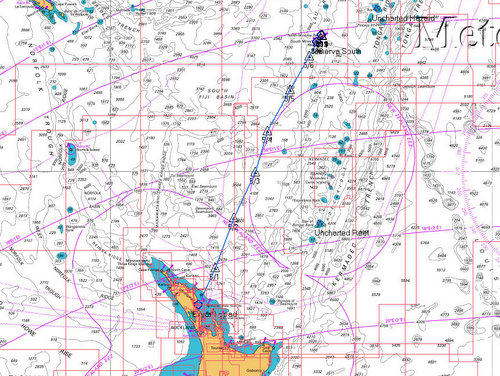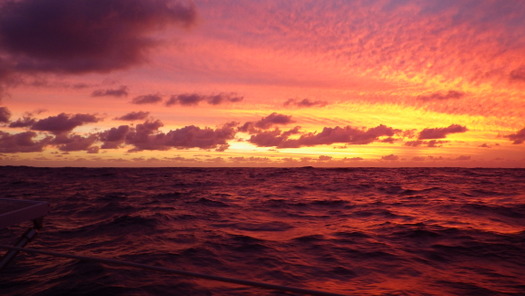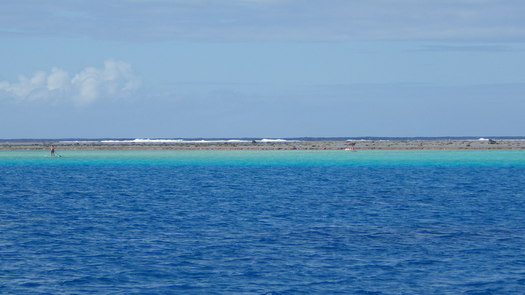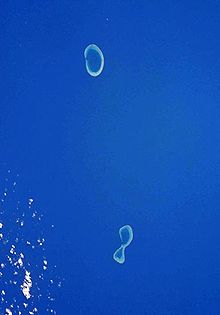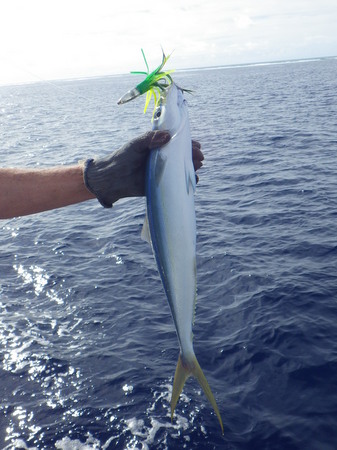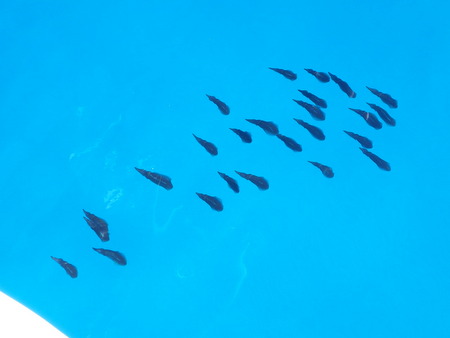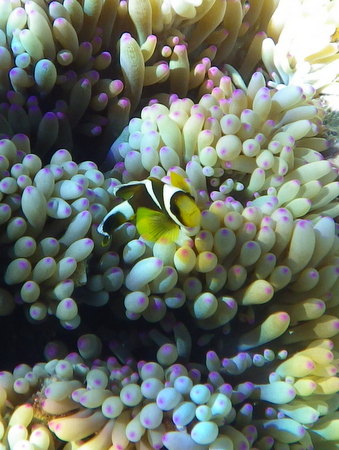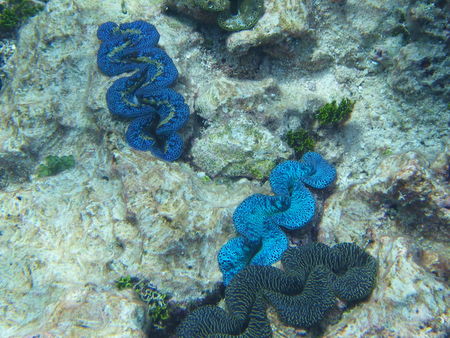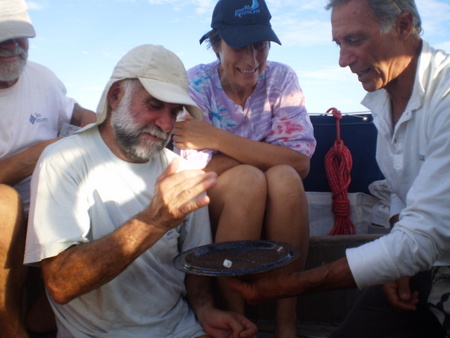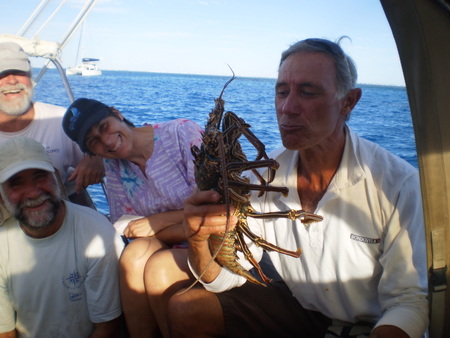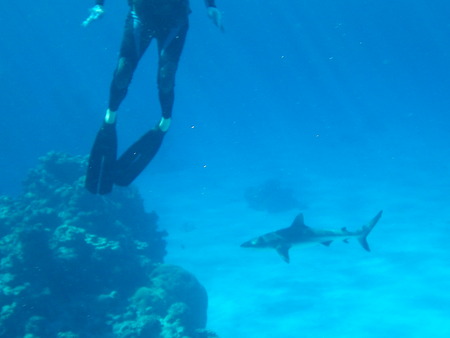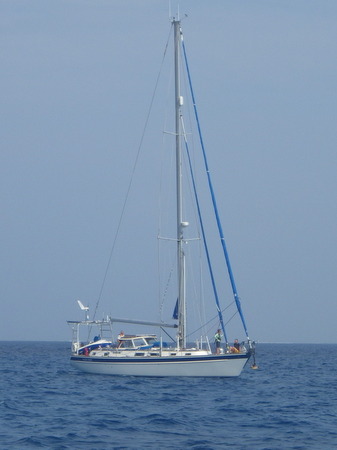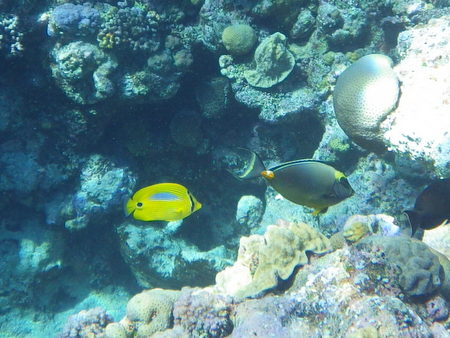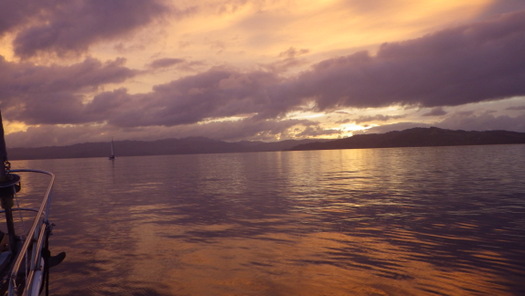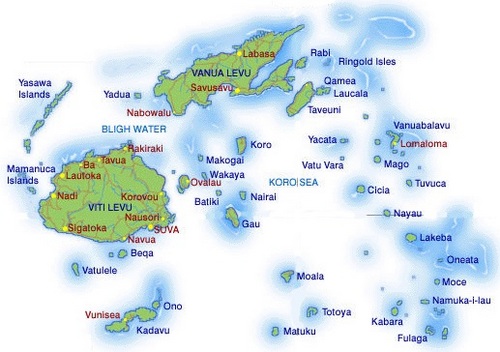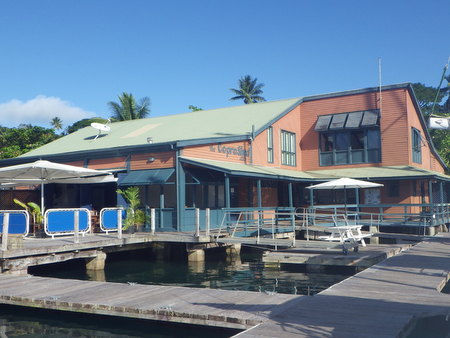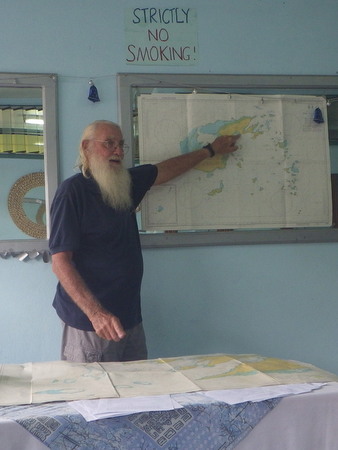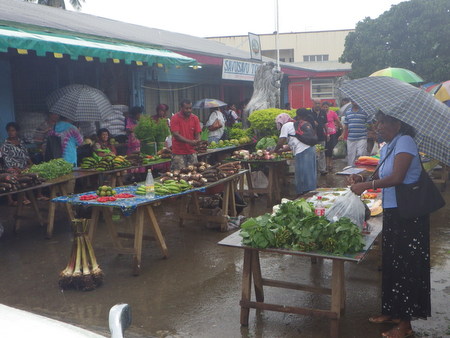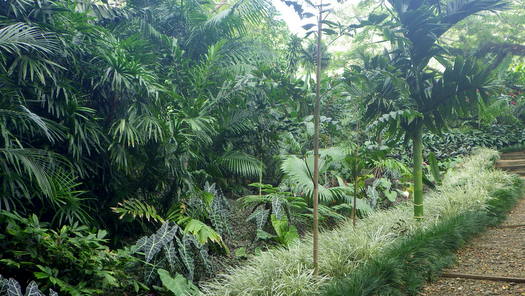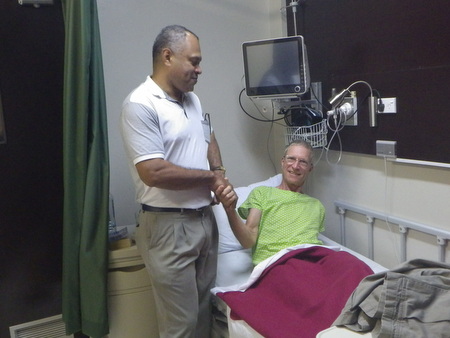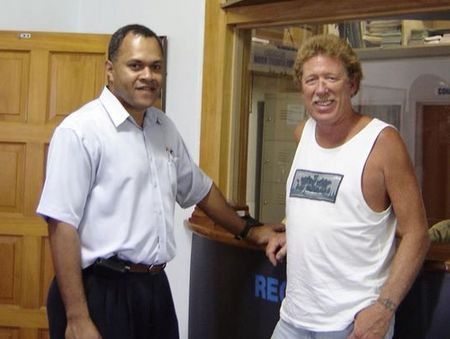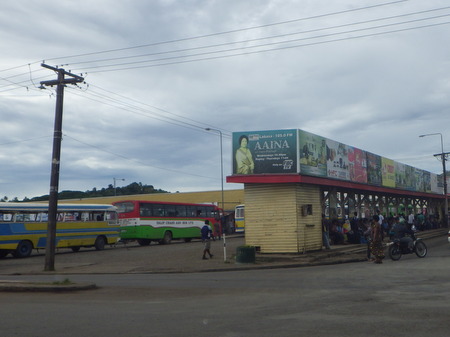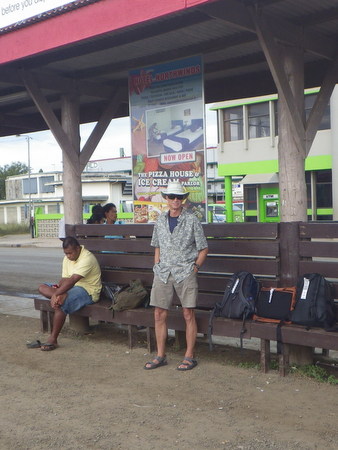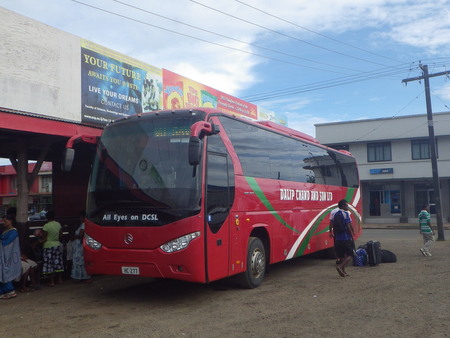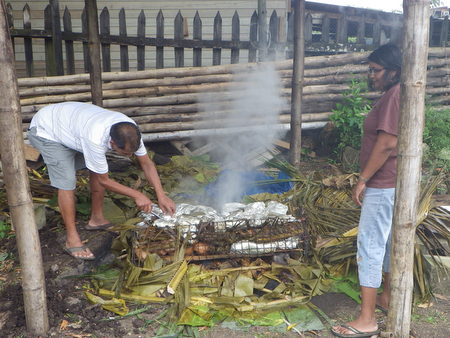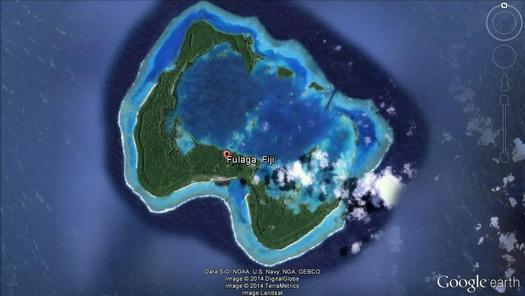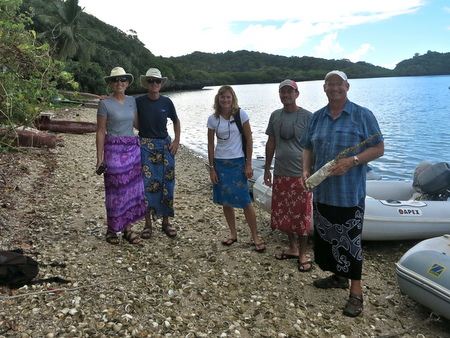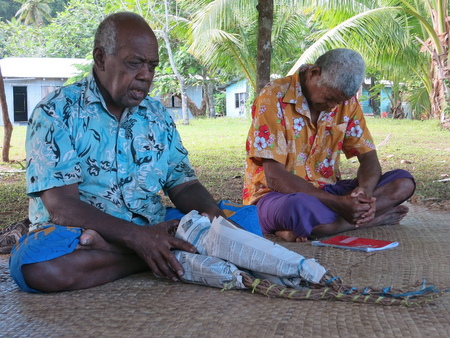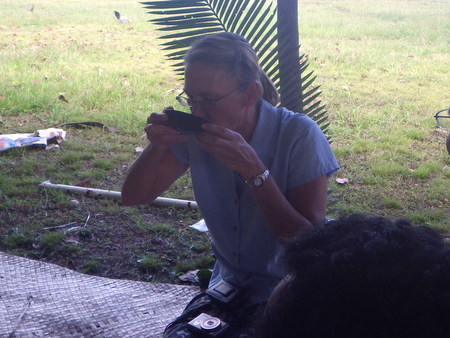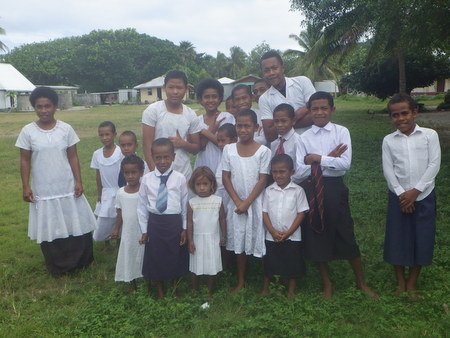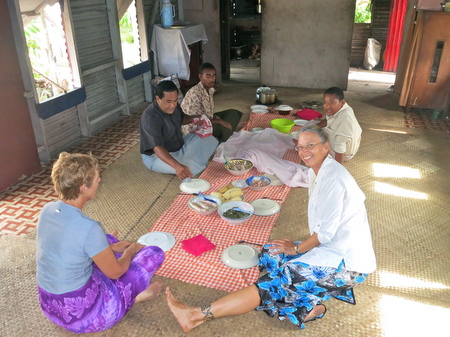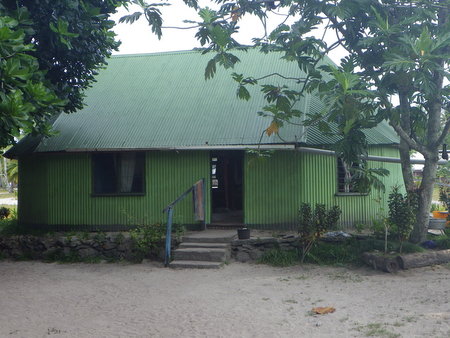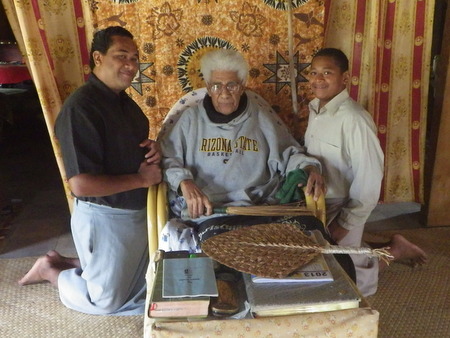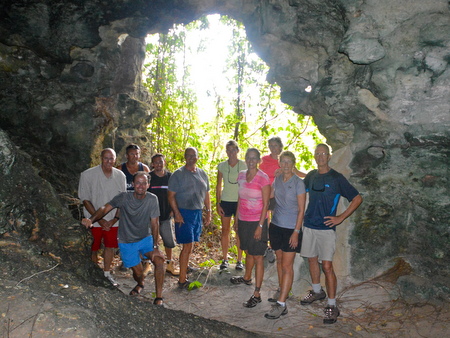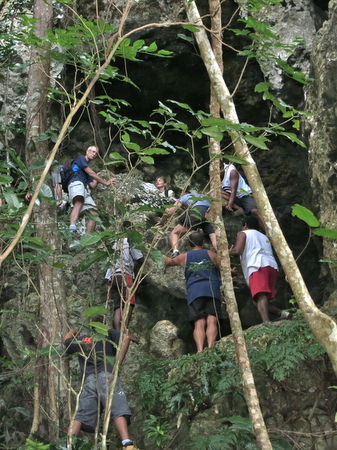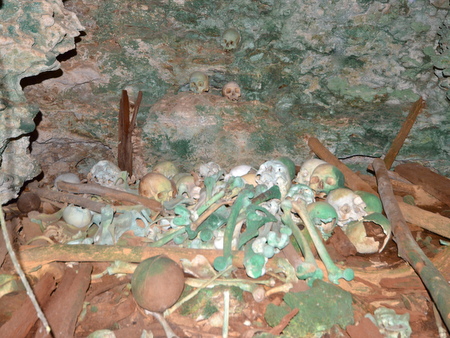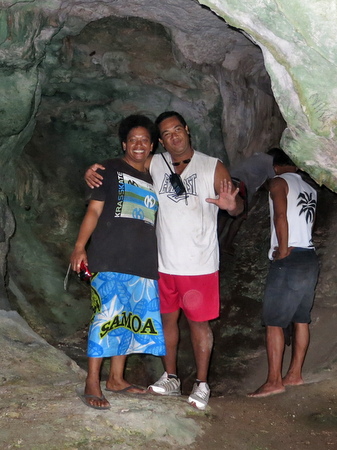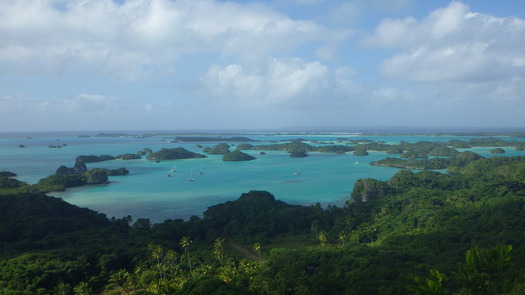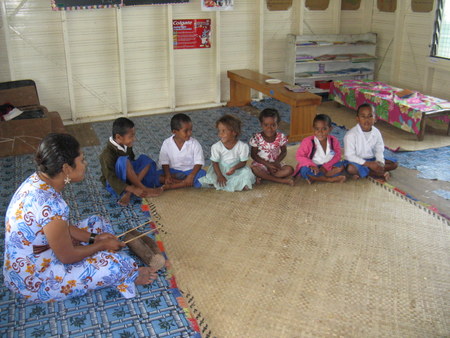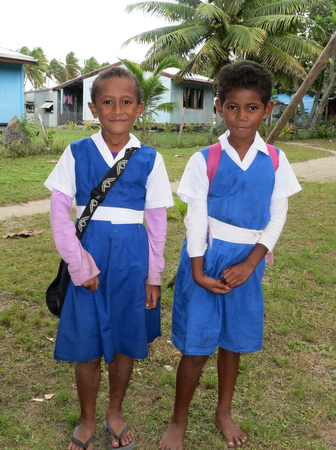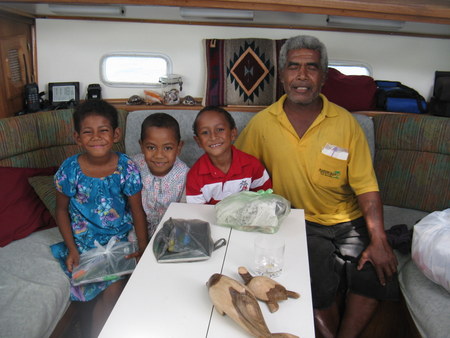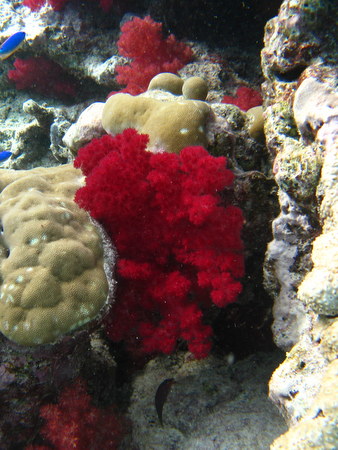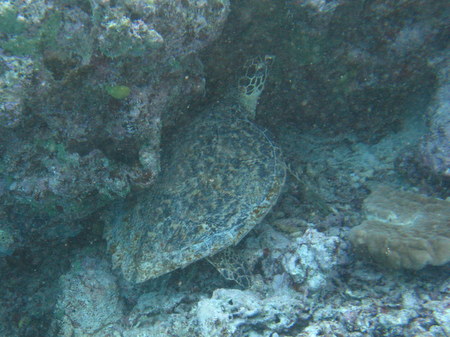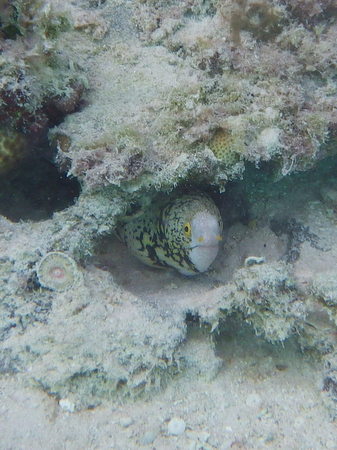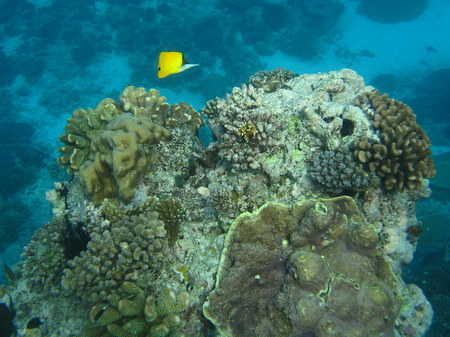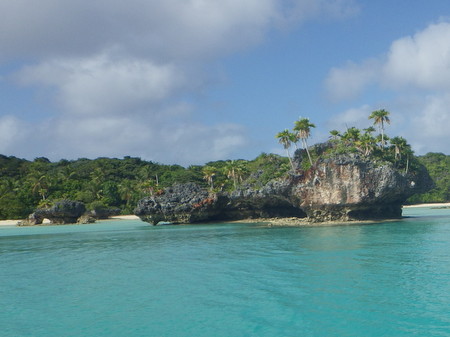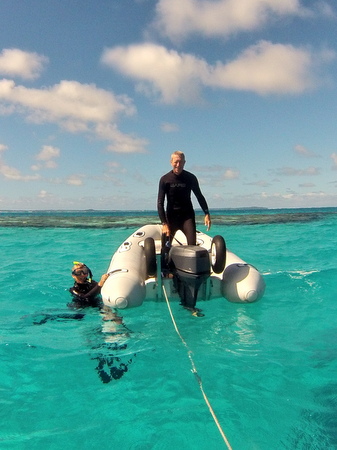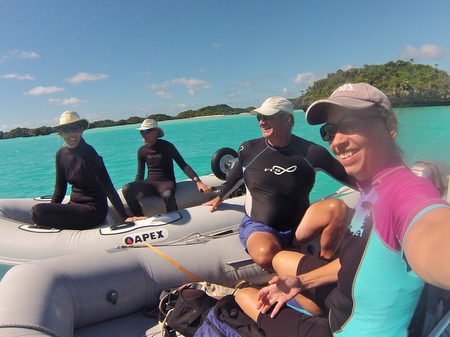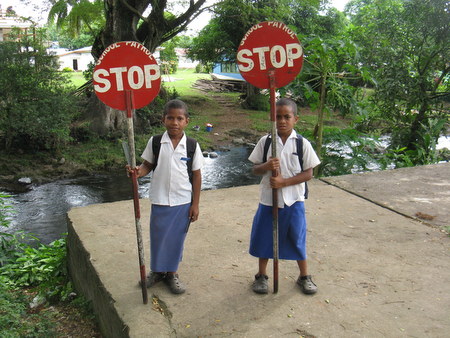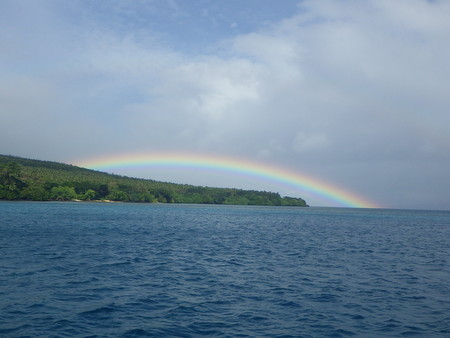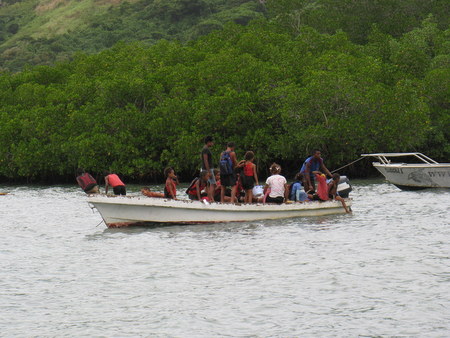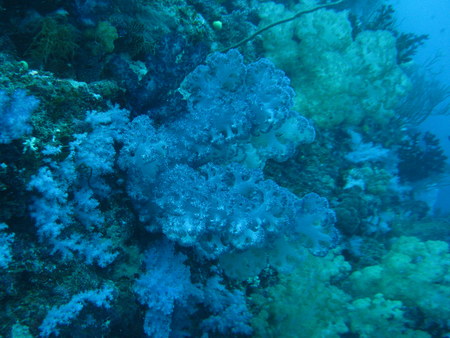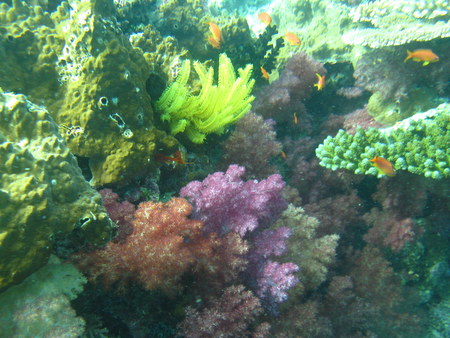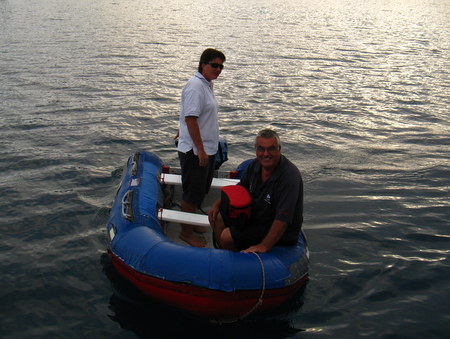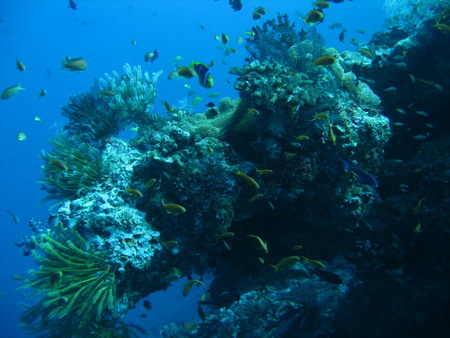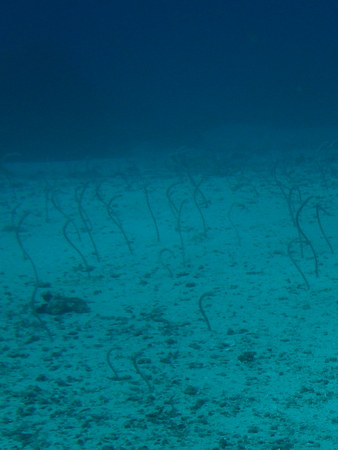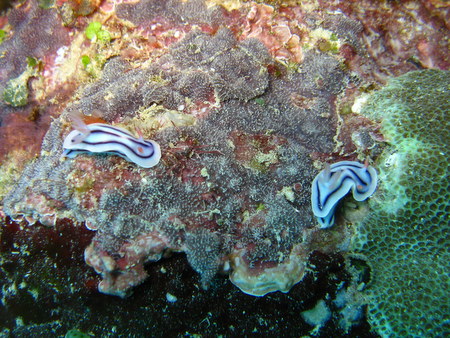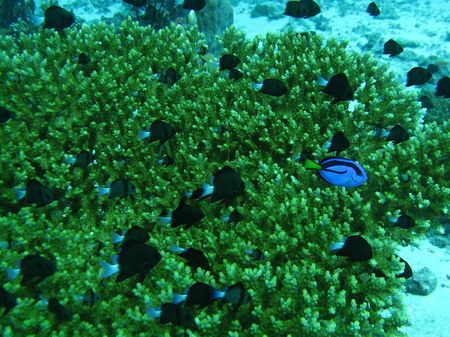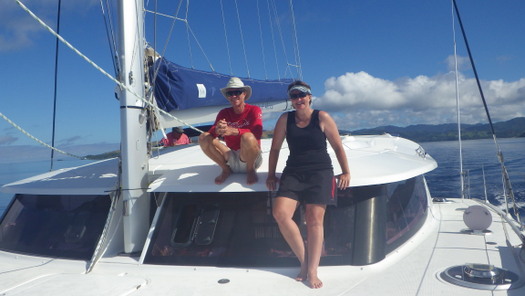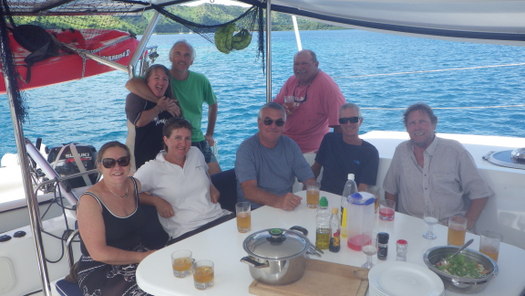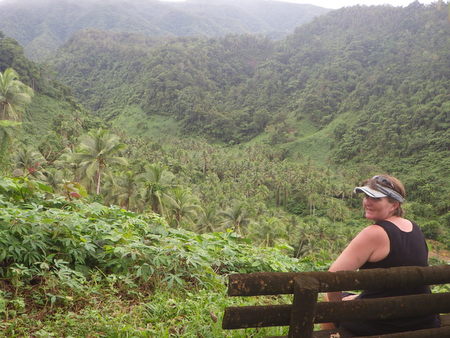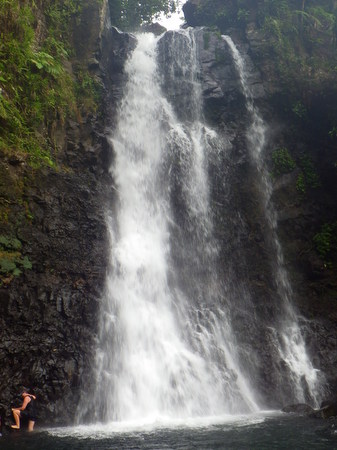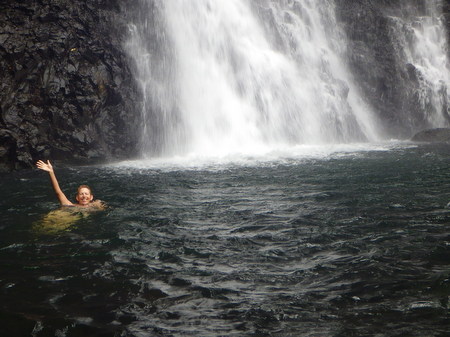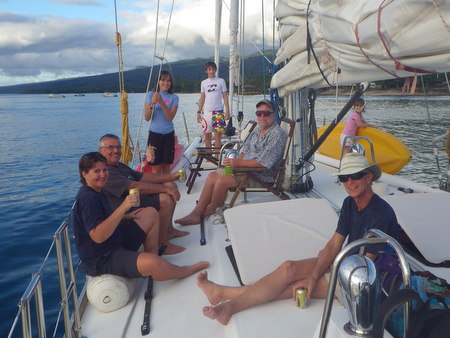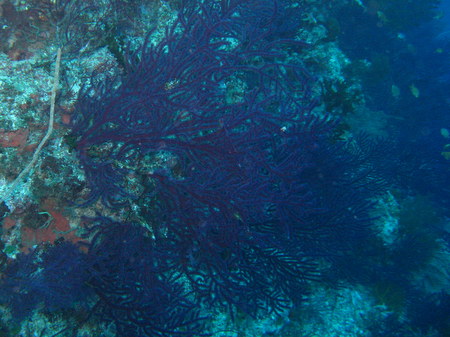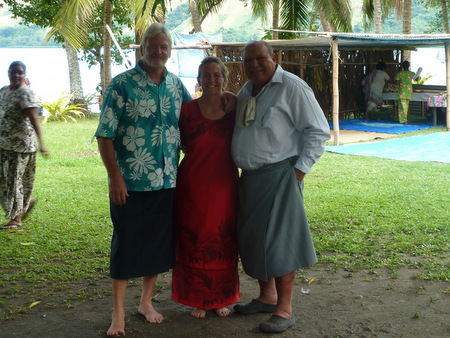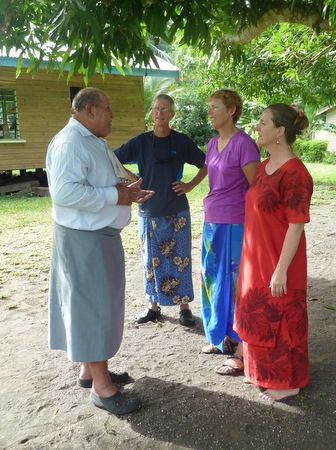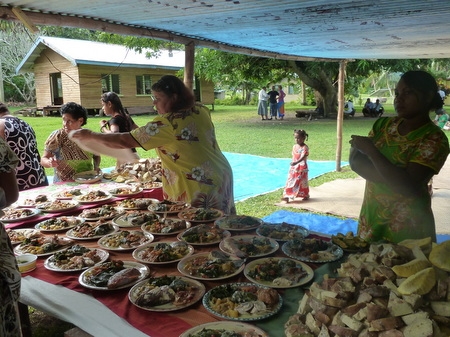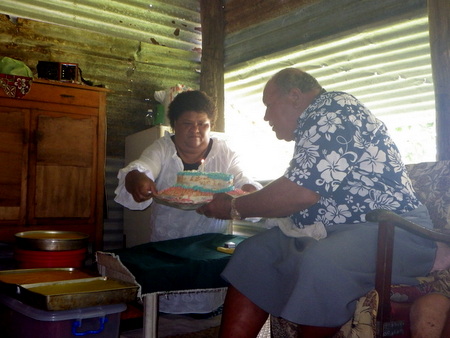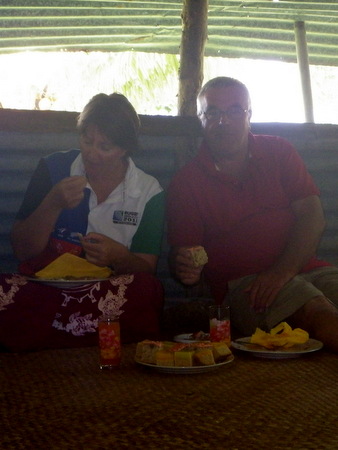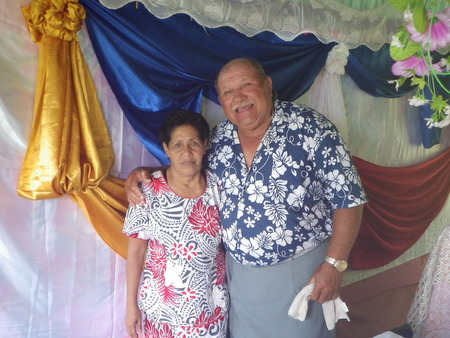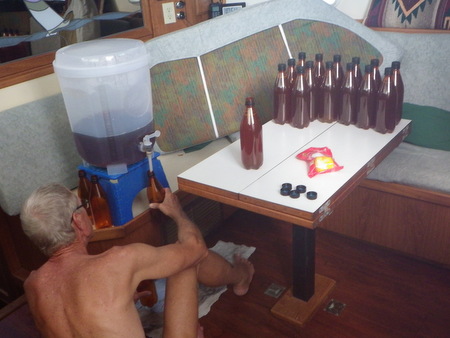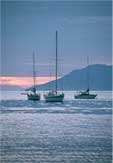
Logbook: Minerva Reef and Fiji Part One - Savusavu, Fulaga, Taveuni & Viani Bay (May to August 2013)
On the last day of April, we said our good-byes to New Zealand and headed north to the tropics. We were well into the Southern Hemisphere Fall by this time, so the days had gotten shorter and the air much cooler, and we were happy to be headed north to warmer weather. Our route from New Zealand would take us first to Minerva Reef, and after a visit there, we would continue to Fiji, where we planned to spend the next several months.Passage from Whangarei, New Zealand to North Minerva Reef (April 30 to May 7, 6 days + 19 hours, 825 nautical miles). The stretch of water between New Zealand and the tropics is one which has caused grief for many a sailor, so both of us were apprehensive as our departure date neared. We were quite fortunate to have had a good passage from Minerva Reef to New Zealand 17 months prior, and for that passage, we engaged the services of Bob McDavitt, a well-known weather router in this area. So, when it was time for us to leave New Zealand and head back north, we again got in touch with Bob. When we told Bob we were ready to go, he recommended waiting a few days because he was watching a low pressure system that he wanted us to avoid. We heeded his advice and waited, but some other boats went ahead and departed. Those other boats had a couple days of very unpleasant weather, and we ended up with another good passage - thank you Bob!!
After doing our departure paperwork with New Zealand Customs in the morning, we left Marsden Cove Marina shortly after noon and rode with the ebbing tide as we motored out the mouth of the Hatea River. Once we cleared Whangarei Heads, we turned north-northeast, and with 10-12 knots of southwest wind and slight seas, we set our sails wing-and-wing and glided along very pleasantly. That night on Rich’s watch (8 pm to 2 am), he was quite pleased to see that the AIS receiver we recently installed was working as advertised and alerted him to two commercial ships, which passed within a couple of miles of us. Although we still always keep a lookout for these ships and any other boat traffic, commercial ships and larger boats are usually broadcasting an AIS signal, which gives us the ship's name, course, speed and closest point of approach - much easier than following a blip on radar to determine whether or not we’re on a collision course. If we are on a collision course, or passing closely and want to be sure that the ship is aware of our presence, we can call the ship on the VHF radio by using its name, which will generally get us a response. Our calls to "big ship at position such and such" often go unanswered.
On Jan’s night watch (2 am to 8 am), the winds got a bit lighter (8-10 knots), and we sailed through an area with a strong west-setting current and confused seas. Our speed diminished, but we managed to sail through it (our speed dropping to 3 knots for a while). There were a number of fishing boats in this area of strong current, and they were not transmitting an AIS signal, so Jan had to keep an eye on them and maintain a safe distance to avoid not only the boats but also any fishing lines or nets. It kept her on edge for a couple hours.
The next few days passed relatively quickly. The winds backed from the southwest to the south to the southeast, and we continued under sail. That low pressure system we were watching was forecast to move off to the southeast, but it turned south, which put us closer to it than we would have liked and gave us some unpleasant seas (2-3 meters), but it also gave us better winds (15-20 knots), so we were making good progress. Those folks who left a couple days ahead of us sailed through the low pressure system and saw up to 50 knots of wind. Yikes!!
During our passage, we kept in touch by radio with several other boats which were also on passage, checking in twice daily to ensure everyone was doing well. We also listened in on a radio sked for boats (about 20 of them) traveling with the Island Cruising Association (ICA) Rally, which left from Opua, New Zealand the day after us. The ICA Rally sked was particularly helpful because they were providing daily weather updates, which we used in conjunction with the weather information we downloaded through our HAM radio email.
Somewhere in the middle of our passage, the winds died out, and we had to motor for about 12 hours. But, it was a short lull, and shortly thereafter, a weather trough brought a few hours of squally weather and up to 25 knots of westerly wind (on our beam). It was not a strong system, however, and about 12 hours later, the winds were back down to 12-15 knots and the seas were pleasant. When the seas calmed down, we put out our fishing lines and landed a mahi mahi (about 15 lbs.). Yum!
Daily progress as charted on our passage from New Zealand to Minerva Reef
About 60 miles from Minerva Reef, the wind completely died, so we fired up the engine again, but since it was late afternoon, we needed to motor slowly to arrive at our destination after sunrise. Seas were calm, the air was pleasantly warm, and we enjoyed a hot shower in the cockpit, the water heated up by the engine. That night, we saw the running lights of a few of the ICA Rally boats in our vicinity; they were also planning a stop at Minerva Reef. Our timing was such that we passed South Minerva in the middle of the night, and as we motored past, we saw anchor lights of some of the faster ICA Rally boats who arrived earlier that day. North and South Minerva are very remote, uninhabited parts of the Pacific Ocean, so it seemed a bit incongruous to see a dozen or so anchor lights in South Minerva as we passed by.
Early the next morning, as we approached North Minerva Reef and waited for better light to enter the pass, we motored along the outside of the reef hoping to land another fish, but after a couple of passes and no hits, we decided to head in and anchor. There was a fair amount of current coming out of the pass (about 4 knots), but Slip Away has a strong engine and we powered on in.
One of several beautiful sunsets while underway
North Minerva Reef at low tide
North and South Minerva Reefs (May 7 to 23). Minerva Reef is owned by Tonga, and it’s a bit of unspoiled paradise. There are two reefs – North & South – and each is an atoll, formed by ancient sunken volcanoes. There are no islands or land masses here – only reef, which is exposed at low tide and covered at high tide. There is a break in both North and South Minerva Reefs, which gives boats access to the inner lagoon and provides a fairly well protected anchorage. North Minerva is a circular shape, and the lagoon is about 3˝ miles (5.5 km) across. South Minerva reef has a figure eight shape, and only the north lobe can be accessed for anchoring. The lagoon at South Minerva is about three miles (5 km) across. The reef at North Minerva is slightly higher, so that anchorage is generally better. The lower reef at South Minerva can make for a fairly rough anchorage at high tide. We anchored in several locations within each of the lagoons, mostly depending on the wind direction.
We visited North Minerva Reef in December 2011 on our way south to New Zealand, and we were very excited to have an opportunity to stop here again on our way north to Fiji. With about a dozen ICA Rally boats in the anchorage with us, it didn’t feel particularly remote, but the folks from the rally were all quite friendly, and they departed after a couple of days, leaving us to enjoy some solitude. Some of the folks on the rally had caught more fish than they could eat, and one of them gave us some fresh yellow-fin tuna. Outstanding!
On our previous visit to Minerva Reef, we spent 8 days and visited only North Minerva. We spent twice as much time on this visit and got to both North and South Minerva. It’s 25 miles from North to South Minerva, so with our average speed of 5 to 6 knots, it takes four to five hours to get from one to the other. But, with the right conditions, we could sail, and this is an excellent fishing area. We did lots of fishing, but unfortunately, we didn’t do so great at catching. On our four passages between the Minervas (twice in each direction), we had numerous hits on our fishing lines but landed only one rainbow runner. Also, we lost five lures, which was very disappointing. We were dying to catch a yellow-fin tuna, but no joy!
Google Earth shots of
North & South Minerva Reefs
Rich eagerly awaiting a strike on one of his lines -
where are those darn fish?!
This rainbow runner gave us a couple of good mealsAlthough we enjoyed scuba diving the pass at North Minerva during our previous visit, we did not have dive buddies this time, so we opted to explore a number of snorkeling locations inside the reef. We found several great spots – beautiful coral heads with super clear water at high tide, and some great sightings, including numerous juvenile fishes (the rockmover wrasse was the most unusual but unfortunately we didn't get a photo of it), lots of colorful giant clams, and a big turtle who must have been very old given the amount of algae growing on his shell (forgot our camera that day!)..
This school of squid was hanging out beside our boat.
The color of the water inside Minerva Reef was such a beautiful blue!
Such a cute juvenile anemonefish
Giant clams
After our first few days at North Minerva, and with a weather forecast looking like the next couple of days would be fairly settled, we decided to venture down to South Minerva. We arrived at South Minerva at the same time as a rain squall, so we waited outside the reef until it passed, and the sun came out briefly so we could find our way into the lagoon. We didn’t have any waypoints, only charts with very little detail, so we needed to keep a sharp lookout for any obstructions. We got in safely, dropped our anchor and since it wasn't very sunny, we decided to wait until morning to snorkel. When we downloaded an updated weather forecast the next morning, it didn't look at all like the previous day's forecast. Unsettled weather was on its way and due to arrive the next day. Dang it! We didn't want to stay in South Minerva in bad weather, so we'd have to head back to North Minerva. Before leaving, however, we jumped in the water and snorkeled the reef at the south end of the lagoon. It was gorgeous! We knew we had to come back!
We sailed back to North Minerva and sat out the bad weather – not a lot of wind, but lots and lots of rain. We topped off our water tanks and filled all of our buckets, and the rain was still falling. It seemed a shame to let all that fresh water fall uncaught.
We had over a week of solitude, which was quite nice, but we were ready for some company when a few other boats started to arrive. The weather was settling down again, so most of the other boats were opting to go into South Minerva, and we headed down there to join them. Alicia and Alfredo (s.v. On Verra) are avid lobster hunters, and on one of their morning hunts, they came back with six lobsters. There were six boats in the anchorage at that time, and they offered each of us a lobster. Each boat cooked their lobster and brought it to a potluck dinner that evening on s.v. Changing Spots, a catamaran which comfortably held all of us. That was one great potluck dinner!
Catch of the Day - 6 nice-sized lobster!
Each boat rolled a die to determine which lobster it would cook for the potluck
Alfredo (s.v. On Verra) - the "lobster whisperer"
Good eating on s.v. Changing SpotsWe spent five days in South Minerva, and a few more boats joined us during that time. We started out anchored in the south end of the lagoon and snorkeled that area as well as the pass. When the wind switched around to the north, we moved and anchored at the north end of the lagoon and snorkeled there. Although the weather was settled, there was a fair amount of swell outside the reef, and we found the South Minerva anchorage at high tide to be pretty uncomfortable. Both of us were woken up most nights for an hour or two when the ocean swell came in over the reef, and it got quite rocky and rolly.
One needs to be comfortable swimming with sharks at Minerva Reef
Vulcan Spirit arrives at South Minerva
Blue-Spot Butterflyfish and Orangespine UnicornfishOur last night in South Minerva was quite memorable, and not in a good way. A nasty storm brewed up (wasn't in the forecast) and passed right over us. It had the worst lightning we’ve ever seen, winds up to 40 knots and driving rain. Minerva Reef took a direct hit from this cell of bad weather because the winds clocked completely around the compass – north to west to south to finally southeast, with a period of relative calm as they eye of the storm passed over us. Several boats (us included) dragged anchor, and On Verra lost their primary anchor and chain - their snubber broke, all of their remaining chain pulled out of the locker, and the shackle attaching the chain to the boat pulled out of the fiberglass. They had to re-anchor in the middle of the storm with their spare anchor and rode (which of course had to be dug out from its storage space). But they, and everyone else in the anchorage, kept their cool, did what needed be done, and no one went on the reef or suffered any significant damage. Storms at anchor are never fun, but this one was especially bad because it was slow moving – it lasted a total of 6 hours, from midnight to 6 a.m. It was a sleepless night for all of us.
The next morning, after On Verra had retrieved their anchor and chain (they had set a GPS waypoint at their anchoring spot), we decided to head back to North Minerva. South Minerva was beautiful, and we had enjoyed the company of our friends there, but we needed a good night’s sleep. Winds were blowing out of the southeast at 15-20 knots, perfect for a good sail back up to North Minerva. Our friends Mark & Anne (s.v. Blue Rodeo) decided to join us at North Minerva. We slept really well that night!
The next day was our last one at Minerva Reef, as we were seeing a good weather window to sail to Fiji, and we felt it was time to move on. We spent the day preparing for our passage, but before leaving, we wanted to snorkel the pass at North Minerva one last time. We enjoyed all of the snorkeling we had done at both North and South Minerva, but the pass at North Minerva was still our favorite spot. Mark & Anne (s.v. Blue Rodeo) joined us and shot video with their Go-Pro camera - great footage!
We were intending to leave for Fiji the next morning, but after taking a second look at the distance we needed to cover, we decided to leave that evening. We ended up departing after dark, which we normally prefer not to do, but we’d been in and out of the pass at North Minerva several times so we could follow our track on our chartplotter. Even better - there was good moonlight, so we could actually see the break in the reef.
Passage from North Minerva Reef to Savusavu Fiji (May 23-27, 3 days + 12 hours, 460 nautical miles). Shortly after motoring out of the pass at Minerva Reef, we set our sails and shut down the engine. Winds were a very pleasant 10-15 knots, a little lighter during that first night, but enough to sail slowly. The next morning, we landed a wahoo, which improved our fishing attitude since we lost so many lures over the past couple of weeks at Minerva. We had great sailing winds for most of this trip – no more than 20 knots - although the seas did get a bit rough (6-9 feet or 2-3 meters) for about 12 hours. Overall it was an excellent passage, with a beautiful full moon on our last night out. The winds died on that last night, so we motored the last 12 hours, and we made landfall in the early morning, following our friends Sandy & Rankin (s.v. Gypsea Heart) into Savusavu. As we approached Savusavu, Jan turned on the radar a couple of times, and was having trouble reconciling what she was seeing on the screen with what she was seeing with her eyes. She finally realized that the radar picture was upside-down. Rats! It appeared that the lightning storm in Minerva had messed with our electronics. Fortunately, as far as we could tell, that was the only thing affected, but we’d need to get it repaired.
It was on this passage that we celebrated a milestone - we had now traveled over 30,000 nautical miles on Slip Away. One can complete a circumnavigation in a couple thousand miles less than we have sailed, yet we're still only one-third of the way around the world. But, we've found so many lovely distractions along the way!
Following s.v. Gypsea Heart into Savusavu at sunriseFiji
Fiji is a nation of islands located in the South Pacific - approximately 1,300 miles (2,100 km) north of New Zealand and 2000 miles (3,200 km) east of Australia. Its territorial limits cover 500,000 square miles (1.3 million square kilometers), but only 7,000 square miles (18,300 square km) of this is dry land. There are over 300 islands, many small ones and four larger ones - Viti Levu, Vanua Levu, Taveuni and Kadavu. The capital of Suva and the international airport at Nadi are located on Viti Levu. The 180-degree meridian separating the eastern and western hemispheres runs through the island of Taveuni, but the international dateline is adjusted eastward so that all of the islands are in the same time zone.
Early inhabitants of Fiji were of Melanesian descent, and Fiji was once known as the "Cannibal Isles." Abel Tasman was the first European to sight Fiji in 1643, and he sailed past the islands, describing an area of treacherous reefs. In the 1830's, a whaling station was established on Ovalau Island, and in 1840, a U.S.-led expedition produced some of the first charts of the area. In addition to whaling, the commodities of sandalwood and bęche-de-mer (sea cucumber considered an aphrodisiac in Asia) brought traders to Fiji in the early 19th century. Missionaries also arrived in the early 19th century to convert the locals and preach against cannibalism.
In 1874, Fiji became a British colony, and shortly thereafter, Britain began to bring indentured laborers to Fiji from India to work the cotton, copra and sugar cane crops. The indentured laborers were brought on five- or ten-year contracts, after which they would be free to return to India - at least that was how it was supposed to work. Most of them ended up staying in Fiji, and many brought their families to live there too. Indenture officially ended in 1919, but by this time over 60,000 indentured laborers were in Fiji. (There is an excellent book, Tears in Paradise by Rajendra Prasad, which tells the story of the indentured laborers and their subsequent struggles in Fiji.)
Indian Fijians are referred to as Indo-Fijians, and the population mix in Fiji today is approximately 57% indigenous Fijians, 37% Indo-Fijians, and 6% other races. There have been tensions between the two primary ethnicities since colonial times, but a thriving economy appeared to keep the situation from boiling over. The basis of the racial tensions has to do with land leases - laws introduced in the late 1800's forbid the sale of native land, so that indigenous Fijians are forever guaranteed ownership of more than 80% of land in Fiji. But, that's just the basis and the tensions run much deeper between these two very different cultures. Fiji became an independent nation in 1970, and shortly thereafter the economy suffered a setback. Racial tensions grew and starting in 1987, the government experienced a series of military coups, the last of which occurred in 2006. That military government is still in place, but Fiji is scheduled to have elections in 2014.
The combination of a temperamental world economy and Fiji's internal political strife has kept the country from flourishing financially, and a quarter of all households live below the poverty level. However, extended family networks of both Indo-Fijians and indigenous Fijians help to support one another.
This volatile history might lead one to believe that Fiji might not be an attractive destination, but that would be an absolutely incorrect assumption. We've known a number of people who have cruised in Fiji, and everyone has had overwhelmingly positive things to say about it. Many people spend years cruising Fiji before moving on to other destinations, and some have imported their boats and taken up permanent residence (within the confines of the immigration laws). Despite the racial tensions, we found the Fijians to be some of the friendliest people we've met in the world. There were times we sensed the racial tensions, but that was really only on the island of Viti Levu (the largest, most industrial and most populated island), and at no time did we feel threatened. (Mostly we just heard negative comments about the opposite race - indigenous Fijians calling Indo-Fijians "greedy" and Indo-Fijians calling the indigenous Fijians "lazy.") We found no Indo-Fijians living on the outer islands, so at least to us outsiders, the problem didn't seem to exist in those villages.
In addition to the friendly local people in Fiji, it has many picturesque tropical islands to explore and offers outstanding scuba diving and snorkeling - Fiji is known as the soft coral capital of the world. We were happy to have several months to explore these beautiful islands.
Savusavu, Vanua Levu, Fiji (May 27 to June 27). As we arrived in Savusavu, we called the Copra Shed Marina on the radio and arranged to take one of their mooring balls. Arriving in Fiji meant clearing in with officialdom, but this was easily accomplished as the marina brought the Customs, Immigration and Health agents to our boat to complete the paperwork. We were checked in shortly after noon, and then we were thrilled to go ashore and have a walk. We hadn’t been on solid ground for almost a month! Although Savusavu is the second largest town on the island of Vanua Levu, it's still a small town with a population of just under 5,000. Nevertheless, it had pretty much everything we needed. We found an ATM to get some Fijian dollars, visited the local market to buy some fresh fruits and veggies (which we’d been out of for a couple of weeks) and ate a meal at a restaurant. Civilization has is benefits!
We spent the next couple of weeks in Savusavu. We hung out with friends, enjoyed meals out, shopped, walked and did a few chores. A Kiwi-expat named Curly Carswell who has lived in Fiji for many years gave a seminar on cruising in Fiji, and it was well attended. On a rainy day, Jan asked a couple of girlfriends to go shopping with her, and by some stroke of luck, she found a great dress for the upcoming wedding of Rich’s son Erik. Since we hadn’t been scuba diving in over a year, we opted to do a dive with a local dive shop before venturing out on our own. Several other yachties wanted to go, so we booked the boat and filled it with our friends. It was a fun day out, but we weren’t particularly impressed with the dive sites we went to that day.
The Copra Shed Marina was a nice gathering place for happy hour
Curly telling us about some of his favorite places in Fiji
A rainy day at the Savusavu fruit and veggie marketAfter a couple of weeks here, we were ready for a change in scenery. We went on one last sightseeing excursion with Ali & Richard (s.v. Vulcan Spirit) to the Flora Tropica Gardens, a beautiful botanical garden with an incredible variety of palms. Ali & Richard rode their bikes to the garden. We took a taxi and then walked the 3 miles (5 km) back to the marina – not a difficult walk, but it was hot and humid, and we were pretty sweaty by the time we got home.
The beautiful grounds of Flora Tropica Gardens
A collection with some very unusual palms
Healthcare in Exotic Locations - An Unplanned Trip to SuvaRich was a little grumpy after walking back from Flora Tropica Gardens, but Jan attributed it to the heat and humidity and didn’t worry too much about it. However, the next morning, as Jan was taking her second sip of coffee, Rich announced to her that he had a “problem” and showed her a significantly enlarged hernia. Yikes! He’d had this hernia for a little while, but it was small and wasn’t bothering him. Since he would be turning 65 shortly and would therefore be Medicare-eligible, we anticipated having the hernia repaired on a trip back to the U.S. However, it was now obvious that we needed to do something immediately. Rich wasn’t in a lot of pain, but it was uncomfortable. He couldn’t push the hernia back into place, and it hurt when he tried.
Here we were in a relatively remote area of Fiji – what to do? We’d seen the local hospital here in Savusavu, and that was not reassuring. However, we were aware that there is a medical school in Suva, the capital city of Fiji, so we thought there must be good services available there.
The first person we called for advice was Curly, who reassured us that there is an excellent private hospital in Suva. He also suggested that we go see Dr. Ishaq, a local doctor at the Savusavu Medical Center (different from the local hospital). Upon examining Rich, Dr. Ishaq felt there was some urgency in attending to this, and he made a couple of phone calls – first, to the local airline to get Rich on a flight to Suva later that day, and second, to the Nasese Medical Center in Suva to schedule an appointment with a surgeon that evening.
Rich flew to Suva that afternoon. Jan wasn’t able to get on that flight (Rich got the last seat), but she was able to get on a flight the next morning. Before Rich took off, we sorted out cell phones for each of us so that we could be in touch with one another. Our friends Ali & Richard (s.v. Vulcan Spirit) assured Jan that they would make sure Slip Away was taken care of while we were gone. Since Slip Away was on a mooring, we had no shore power, and the generator needed to be run for an hour or so most days to keep our batteries charged.
The Nasese Medical Center where Rich was referred by Dr. Ishaq was not the same facility as the private hospital which Curly told us about, and Rich’s initial impression wasn’t completely favorable. It’s not a big hospital, but rather a small clinic. Rich arrived on a rainy day, and the waiting room was packed with people and dirty – lots of mud tracked in off the street. The exam room was clean, but not as modern as he might have hoped. We have seen doctors and visited healthcare facilities in third-world countries in the past, but needless to say, Rich was feeling apprehensive about having surgery and wanted to make sure this place was first-rate. We weren’t really sure how to check on the clinic’s reputation, but then Jan thought to "Google" it, and she found the Nasese Medical Center listed on the American Embassy’s website – a very positive indication. Once Rich got past the waiting room and initial exam room, the surgical facilities were excellent.
Jan arrived in Suva the next morning, Rich was operated on that evening, and the surgery went well. The surgery was performed by Dr. Sitiveni Vudiniabola (aka "Dr. Siti"), and he was not only an excellent surgeon, but also a super nice guy. Rich had had double inguinal hernia surgery in Panama City (Panama) in 2010, and Dr. Siti advised us that those hernia repairs were intact and done well. This was a new hernia - a femoral hernia (near the femoral artery), a more unusual hernia and more common in women than men. Shortly after Rich's surgery, we found out that Dr. Siti had done surgery on our friend Jim McConn, who was cruising in Fiji a few years earlier. Small world!
Dr. Siti checking up on Rich
A few years earlier - Dr. Siti with our friend Jim (s.v. Spanish Stroll)Rich spent the night of his surgery at the surgical center (his 65th birthday!), and Jan met him there the next morning. We spent some time talking with Dr. Siti, and he was pleased that Rich was doing so well. We left the Medical Center and checked into a bed & breakfast called Island Accommodation for a few days so that Rich could rest and recover before returning to Slip Away. Island Accommodation was quiet, accommodations were extremely comfortable, and the folks who ran the place were delightful. Their normal bed & breakfast rooms were booked, so they gave us a room in a two-bedroom flat. The other bedroom was empty, so we had the whole place to ourselves – living room, dining room and full kitchen. It was the perfect place for Rich to recuperate for a few days. Suva’s downtown area was about a 20 minute walk away, so Rich rested, and Jan walked into town most days. Our B&B was located near Fiji National University where Dr. Siti teaches at the Medical School, and on our last day in Suva, he stopped by to check on Rich and gave him the OK to go home.
Back to Savusavu
When we flew to and from Suva, flights in and out of Savusavu were sold out, so we ended up flying in and out of Labasa, which is the largest town on Vanua Levu and a couple hours away from Savusavu. When we flew to Suva, we took a cab from Savusavu which cost FJD $100 (about USD $55). We learned we could take a “luxury bus” from Labasa back to Savusavu for FJD $8, and Rich said he felt well enough to give it a go. The bus ride was fine, not the most luxurious bus we’ve ever taken, but it was air-conditioned with relatively comfortable seats (as opposed to being packed into an old school bus). The trip took about 2˝ hours, and they showed a movie on the way – The Call with Halle Berry – a horrible, violent movie. We (and especially Jan) are not big fans of suspense films, and we felt somewhat embarrassed watching an American movie like this in a foreign country. Do these people think that this is an example of life in the USA?
The Labasa Bus Station with a couple of the non-luxury buses
Rich patiently waiting for our bus to arrive
Our bus to Savusavu - not bad!When we arrived at the bus depot in Savusavu, we were met by Richard (s.v. Vulcan Spirit), who grabbed our bags and walked us to our dinghy, which he had brought to the dock for us. When we climbed on to Slip Away, we found a cake in the cockpit, left by our friends Heather & Jon (s.v. Evergreen), and shortly afterward Richard & Ali stopped by with some fresh fruits and veggies for us. We were feeling the love!
We spent a couple more weeks in Savusavu. Rich was recovering well, and we caught up with more friends who had recently arrived from New Zealand. A number of these folks had really rough passages from New Zealand to Fiji, and we were reminded again how lucky we were to have had a good one! Most of our friends came into Savusavu, stayed a short while and then moved on. It was hard to watch everyone come and go, and we weren’t particularly thrilled with hanging out in Savusavu, but Rich needed to recuperate before we ventured further afield. We found good company with Bob & Ann (s.v. Charisma) who were also stuck in Savusavu for a few weeks waiting for parts for an engine repair. We had only recently met Bob & Ann, but they ended up looking after Slip Away for much of the time while we were in Suva so that Vulcan Spirit could go out scuba diving for a few days.
Slip Away on her mooring in Savusavu
One Sunday afternoon we attended a "lovo" at the Planter's Club in Savusavu
- a good meal for FJD $10/person (about USD $5.50)Three weeks after Rich’s surgery, we found an opportunity to move on. Although Rich wasn’t ready yet to go sailing in any kind of seas, a motor boat ride on calm seas would be just fine, and we had a weather forecast calling for several days of light winds and calm seas. We debated about where to go, and were especially interested in going somewhere in the Lau Group of islands, which are some of the most remote and traditional Fijian islands. Bob & Ann (s.v. Charisma) suggested heading with them to Fulaga in the Southern Lau. Fulaga is in the very southeastern corner of Fiji, and since the prevailing tradewinds are southeasterlies, it’s one of the hardest to get to and therefore one of the least visited islands in Fiji. Fulaga sounded very appealing, so that was the plan.
We had a few chores to do before departing, and we normally have a fairly established division of labor, but since Rich was on “light duty”, Jan needed to help him with a few of his jobs. So, in addition to making sure we had food (which we’d need a lot of since we’d be in a remote area for a while), money (fortunately, not much of that needed), clean laundry, our cruising permit from the Customs office, kava (a gift for the local village chiefs) and a course charted to our destination, Jan also had to top off our fuel by hauling several jerry jugs of diesel and gasoline from the local gas station. The job is made easier by a cart, which we use to transport the jugs from the dinghy dock to the fuel station, and Jan usually found a helping hand from one of the other guys when it came to loading the full jerry jugs into our dinghy. Also, we used a winch and halyard to haul the full jerry jugs up on to Slip Away’s deck. After a few trips, we were ready to go.
Passage from Savusavu to Fulaga (June 27 to 29, 200 nm, 43 hours). We left Savusavu late in the afternoon and as expected, spent our first few hours motoring with very little wind. That evening we had a pleasant surprise when the wind came up to 8-10 knots from the northeast, and we enjoyed a few hours of sailing. The sailing didn't last long, however, as shortly before midnight, the wind died completely. The engine came back on, and we motored the rest of the way to our destination. We arrived outside the entrance to Fulaga early in the morning, and we needed to wait a few hours for the sun to get higher in the sky (for better visibility) and for slack tide to enter the lagoon. There was no wind and the seas were glassy calm, so we turned off the engine and drifted for a few hours while we waited. We cooked a nice breakfast, showered, turned on our watermaker to top off our water tank, and tidied the boat. Shortly after 10 a.m., we started the engine and motored into the lagoon.
Arriving Fulaga in flat calm conditions
Google Earth shot of FulagaFulaga, Lau Group (June 29 to July 13). The island of Fulaga sits near the southeastern corner of the Fiji archipelago. It consists of an oval rim of jungle-covered hills which almost completely surround a lagoon that measures about 6 miles by 5 miles. On the eastern side of the island, there is a break in the reef which allows access to the lagoon, and inside the lagoon are numerous mushroom-shaped limestone islets. It's all quite beautiful and there are several good spots to anchor. There are three villages on the islands with a total population of about 400. Fulaga is very isolated with no airport and infrequent visits from ships. The locals live mostly off the land and the sea, with fish, coconut, taro and taro leaves the main staples of their diets. A number of the villagers are wood carvers, and they send their carvings by ship to the main islands where they are sold to the tourist industry.
The main village at Fulaga is Moana-i-cake, and our first order of business upon arrival was "sevusevu." Sevusevu is a ceremony in which we present a bundle of "kava" (or "yagona") to the village elders (sometimes the chief, and sometimes another representative) and ask permission to visit their island, swim in their waters, fish, snorkel, scuba dive or whatever. Kava is a pepper plant, and the root is pounded (in previous times, chewed) and mixed with water in a large bowl. The liquid is drunk and if one drinks enough, it has a narcotic effect. In a kava ceremony, everyone has an opportunity to drink some kava, accompanied by some chanting and clapping. This was our first opportunity to do sevusevu, and there is an air of mystery about it before the first time, but it was all very straightforward.
Charisma, Evergreen and Slip Away all arrived in Fulaga on the same morning, so we all went ashore together to do sevusevu. Dress is important for the sevusevu ceremony - everyone (both men and women) wears a "sulu" (a sarong or pareo). We landed our dinghies on a beach near a trail and walked about 20 minutes to the village. As we reached the edge of the village, one of the locals met us and walked us to a small shelter where we presented sevusevu. The village elder accepted and blessed the kava we presented. They already had some "grog" mixed up in the large kava bowl, and we each had an opportunity to drink a small "bowl" (served in a coconut shell). We'd heard that it tasted like dirty dishwater, and both of us were a little concerned that we might gag on it, but fortunately that didn't happen. We didn't think it tasted like dirty dishwater, just dirty water, and since the drink is mixed from the root of a pepper plant, it made our tongue and lips tingle a bit.
The crews of Slip Away, Evergreen and Charisma dressed in our sulus
and ready for our sevusevu ceremony
Village spokesman blessing our gifts of kava
Signing the village guestbook at the sevusevu ceremony,
with the kava bowl in the foreground - doesn't that look tasty?!
Ann from Charisma getting her first taste of kava
The next day was Sunday, and we were invited to attend church in the village. Heather & Jon (s.v. Evergreen) planned to skip church and go for a walk, but we and Ann & Bob (s.v. Charisma) decided we'd give it a go. When we got to the church, one of the young girls named Sera escorted us to seats, and after some of the other locals came into the church, we realized all the adults were sitting on the other side of the church - we were seated on the kids' side. The music was a capella - no instruments, but beautiful voices singing with enthusiasm. The kids were seated in the pews in front of us, and every once in a while, we'd see one of the local men walk up the side aisle carrying a long stick. If one of the kids was misbehaving, he or she would get a poke. After a few times of seeing this guy walk up the aisle, the four of us also seemed to straighten up a bit when he walked by.
After church, we were invited to lunch at Matai and Ma's house. Matai is the grandson of the chief, and he and his wife Ma took us under their wing while we were in Fulaga. There was a nice spread of food at lunch, and it was quite tasty - fish and octopus soaked in coconut milk (delicious!), taro and cassava (starchy vegetables), and pulisami (young leaves of the taro plant, soaked in coconut milk). During lunch Matai asked if we would be interested in doing a hike the next day to some vista points, a cave and a ceremonial place with skulls and bones from the days of cannibalism. We were all enthusiastic about this and agreed to meet him in the village the next morning. After lunch, as we walked back to our dinghies, we ran into Jon & Heather (s.v. Evergreen). Their walk along a path leading out of the village led them to another smaller village, where they ended up attending church and having lunch with another family. They, too, had a good day.
Fulaga kids dressed up in their Sunday best
Lunch at the home of Matai & Ma
The Chief's home in Fulaga
Chief Daniel, his grandson Matai on the left and Matai's son Wise on the right.
Matai's father is deceased.In addition to the crews from Charisma, Evergreen and Slip Away, a few others joined us on the hike the next day. The hike was challenging, but the views of the island and lagoon were stunning, the cave was interesting and the skulls and bones were a bit eerie. After the hike, Ma served us all a plate of curry rice for lunch. We were amazed at the hospitality extended to us and the generosity of these people who live such a basic existence.
Spelunkers - crews from Blue Rodeo, Charisma, Just in Time,
Evergreen & Slip Away
The hike involved rock-climbing in certain sections
Skulls and bones left over from cannibal days
Our lovely hosts Matai & Ma
Bird's eye view of Fulaga's lagoonOn another day, Jan visited the primary school in the main village with Jon & Heather (s.v. Evergreen). The kids in kindergarten performed a few songs and dances for us (so cute!), and we spent some time seated at the front of a class of 5th graders, telling them about our boats, where we lived in America, the places we've visited in our travels, and answering any questions they had for us. While we were visiting the school, Tai, one of the village elders asked if he could bring a few of the kids out to our boats on a Saturday when they weren't in school. Jon, Heather & Jan agreed, and the following Saturday, Slip Away and Evergreen hosted six little girls (7 and 8 year olds - three on each boat) for about an hour. Tai joined us on Slip Away and served as a translator, which helped a lot because the kids didn't speak much English. Jan baked them chocolate chip cookies, which disappeared in a flash, and they brought us lovely gifts - carvings of dolphins and turtles and a purse for Jan woven from pandanus leaves. We reciprocated with gifts to them of notebooks and colored markers, which appeared to be a big hit.
Kindergarten classroom
Vulisere and Penina in their school uniforms
Visitors on Slip Away (l to r) Penina, Laisiana, Vulisere and village elder Tai.
In the foreground are a couple of the wood-carving gifts they brought us.We ended up spending a total of three weeks in Fulaga. We moved between a couple of anchorages - one near the village and another closer to the pass and outer reef. Both anchorages were excellent. They offered good protection from wind and seas, great holding in sticky sand, and there were few, if any, coral heads to ensnare the anchor chain. A number of boats had taken advantage of the weather window to get to Fulaga, so there were about 20 of us scattered among a few anchorages, but there was plenty of room, and it did not seem crowded. There were numerous places to explore by dinghy, and we did lots of beachcombing and snorkeling. Rich didn't scuba dive since he was still recovering from his surgery, and Jan did only one dive because conditions were often rougher than either of us felt comfortable with. The best places to dive were in the pass and on the outside of the reef, which were exposed to the tradewinds. The tradewinds blow their strongest in July and August, and therefore the seas are also their roughest. On one of the rough days, one couple who went out to dive the pass were flipped over in their dinghy. Fortunately, no one was seriously hurt (a few scrapes and bruises), and there were several others around to assist them, but that incident made us even more wary. There were numerous places to snorkel which were protected by the fringing reef, so we spent most of our time exploring those, some of which were excellent and others just so-so. We did snorkel the pass a couple of times in moderate conditions and saw some great stuff, including a school of very large bumphead parrotfish - very cool!
Pretty reef and colorful fishes
Vibrant soft coral
One of our favorite sightings - an emperor angelfish
Turtle well camouflaged on the reef
Snowflake moray eel
Long-nose butterflyfish swimming in "gin clear" water
Mushroom-shaped limestone islets inside the reef
Climbing back in the dinghy after a snorkel
Snorkel excursion with Bob & Ann (s.v. Charisma)We could have been content hanging out in Fulaga for much longer, but there was lots more we wanted to see in Fiji, so we sadly said good-bye to the local people who had so graciously welcomed us here. From Fulaga, we were heading back north to Taveuni and Viani Bay (on the east coast of Vanua Levu).
Passage from Fulaga to Taveuni Island (July 13-14, 187 nm, 32 hours). We got an early start from Fulaga and had a smooth exit from the pass. Since we were headed north, the southeast tradewinds were working in our favor. With 15-20 knots of wind on our starboard quarter for most of the trip, we averaged over 6 knots on our passage north to Taveuni - pretty fast for Slip Away! We had good wind until we entered the Somosomo Straits, when we were shadowed by the island and becalmed, so we motored the last 12 miles to a spot near the northwest end of the island where we dropped our anchor.
Taveuni Island (July 14-17). Taveuni is Fiji's fourth largest island and known as the "Garden Isle" because it is green and lush with beautiful rainforest and waterfalls. It is volcanic and high, with two peaks over 1000 meters (3280 feet), Des Voeux Peak (1195 meters or 3920 feet) and Mt. Uluigalau (1241 meters or 4071 feet). Much of the eastern side of the island has been designated as National Park. There are no major towns on Taveuni, but the largest village of Somosomo has a couple of grocery stores and a daily market selling fruits and veggies along the side of the road. The 180th meridian of longitude runs through the middle of Taveuni, with half of the island in the eastern hemisphere, and the other in the western hemisphere.
Our first order of business when we got to Taveuni was to buy some food. Three weeks in Fulaga had depleted all of our fresh fruits and veggies, and we had used up quite a few canned and dry goods too. Somosomo has a Morris Hedstrom grocery store (aka MH, which is Fiji's largest grocery chain), as well as the roadside fruit and vegetable stands, so we planned to do some provisioning. After a good night's rest at our anchorage near the northwest end of the island, we moved Slip Away to an anchorage in front of the Taveuni Ocean Sports Dive Shop. We were told that this was a good anchorage, and it was five miles closer to the grocery store, which made it a walk-able distance. We dropped the anchor, dinghied ashore and started walking toward town, but we didn't get far when a local guy stopped and gave us a ride. We did our shopping and caught a cab back to the anchorage, and when we returned, the tide was out, and an on-shore breeze had come up. Neither of us felt comfortable in this anchorage - Slip Away was way too close to a reef which came out from the shoreline. Before the groceries were put away, we weighed anchor and headed back to the previous night's anchorage. That night and the next morning, we had some high winds and heavy rains, but Slip Away was quite secure, and we were both happy that we had returned to this spot. The wind and rain abated in the afternoon, so we took the dinghy ashore and went for a walk around the north end of the island. Taveuni gets a lot of rain, and the island is very green - very pretty! We walked past the airport to a small village and found a small grocery store, where we got an ice cream - boy, did that taste good! This store actually had some better stuff than the MH in Somosomo, and we picked up a few more items. That evening, the winds shifted a bit, and we got some ocean swell wrapping around the north end of the island, making our anchorage rolly. Time to move on!
School patrol boys in Somosomo
Rainbow on the morning of a stormy day
Viani Bay, Vanua Levu (July 17 to August 6). The trip from Taveuni to Viani Bay near the southeastern corner of Vanua Levu wasn't far - just 17 nautical miles across the Somosomo Straits. The wind was gusty - 15 to 25 knots - but the seas weren't bad, and we sailed with just a headsail, a pretty easy three-hour trip.
Viani Bay is a good anchorage as a base from which to scuba dive in the Somosomo Straits, an area generally referred to as Rainbow Reef, which hosts some of Fiji's best diving. A local guy named Jack Fisher and his wife Sofie live in Viani Bay, and Jack is a bit of an icon in the cruising community. He is a very sociable sort, loves the company of the cruising community and provides excellent "tour guide" services to us. When Jack was younger, he drove a boat for a dive shop, so he knows the locations of all the good scuba diving and snorkeling sites, and he will accompany cruisers on our boats to take us out to snorkel or dive on the sites, most of which are only a few miles from Viani Bay. Jack doesn't dive with us, but when we're in the water scuba diving or snorkeling, he provides surface support by either staying on board the mothership or following our bubbles in the dinghy and picking us up at the end of the dive. He charges FJD $10 per person per trip, and we also provide snacks and lunch for him. Since most cruisers are on somewhat of a budget, this is a fantastic deal for us and makes it affordable to do repetitive dives on these world-class dive sites. And, we understand that Jack is generous with the money he makes. The kids in Viani Bay are transported to school by boat, and Jack recently bought them a new one.
Kids in Viani Bay getting dropped off by the local school boatAlthough trips with Jack are a great way to dive the sites in this area, friends who had previously been in Viani Bay suggested that we do the famous "Great White Wall" dive with a local dive shop and highly recommended Taveuni Ocean Sports. Most dive shops only dive the Great White Wall a few days each month - during neap tides due to the currents at that site. The dive was available a couple of days after we arrived in Viani Bay, so we booked the trip. We were having some rough weather during that time, but we got a lucky break on that day and had settled conditions. (They had cancelled the dive scheduled on the previous day.) The Great White Wall is an underwater wall that is covered by white soft corals - very unique. It is a drift dive because the coral polyps are open only when the current is flowing.
White soft corals on the Great White Wall dive
Some of the other colorful soft corals on the Rainbow Reef
A few days later, our friends Kerri & Andrew (s.v. Mariposa) joined us in Viani Bay, a rendezvous we'd be planning for a few weeks. They are good friends and great dive buddies. In addition to doing several dives together, we shared meals, adult beverages and lots of great conversation. On our first dive with Jack, he took the four of us to the Great White Wall on Slip Away, but our second dive at this site was more of an adventure than we would have liked when a strong current came up toward the end of the dive. Slip Away was tied to the dive site mooring, Jack was on board, and our dinghies were in the water trailing out behind Slip Away. We used our dinghies to get in and out of the water with our dive gear - easier than trying to do it from the mothership. It was helpful that the two of us dove the site previously, as we knew the lay of the land (this was Kerri & Andrew's first time). We descended, swam through a large cavern, drifted slowly along the wall at about 70 to 80 feet of depth, then came up to the top of the wall at about 40 feet and swam back toward the mooring. Kerri & Andrew surfaced a few minutes earlier than us and had climbed in their dinghy. We were nearing the end of our dive and started swimming toward the base of the mooring, when we felt the current starting to build. We ended up crawling along the top of the wall, grabbing onto rocks to make forward progress. Rich reached the mooring line first, held on, and stuck out his fin so Jan could grab it and pull herself to the line too. We ascended holding on to the line, which took a fair amount of strength as we estimated the current was running at 4 or 5 knots. We did our three-minute safety stop at 15 feet, and when we surfaced, we were pinned against the bow of the boat. We had a long line sitting our on deck, and Jack dropped it over the side to us. We grabbed on to it, and he held it while we drifted back to the dinghies. We were able to grab and hold on to the dinghy, but with the current, it was impossible to hold on while taking off our dive gear and climbing in. Kerri is a PADI dive instructor and saved the day for us. She and Andrew were still in their dinghy, and although our dinghies were close in proximity, they were not close enough for her to climb from one to the other. She had to jump into the water in order to reach our dinghy and pull herself in. Once she was in our dinghy, she took our gear from us and helped us in. We were remembering friends telling us that Jack provides a "good service," but he has "his limitations." We also now understood why friends suggested that we dive the Great White Wall with a dive shop. This experience with Jack didn't instill a lot of confidence, especially since it was our first dive with him, and we shudder to think of what could have happened with less-experienced divers. Subsequent dives with Jack were done at sites with less current and went fairly well - a few moments of adventure but nothing like that first time.
Our friends Kerri & Andrew, s.v. MariposaThe scuba diving from Viani Bay was outstanding! On subsequent trips, Jack took us to sites called The Fish Factory and Cabbage Patch - a few times to each site, and each time was a new and different experience. The water was super clear, the soft corals were beautiful and colorful, and we saw great marine life, not only tons of fishes but also numerous nudibranchs, small "sea slugs" which are generally not plentiful and can be difficult to spot. There were usually a few boats in the Viani Bay anchorage, and we all took turns being the "host" boat, taking out whomever wanted to dive or snorkel for the day. We took Slip Away a couple of times - once with a total of nine people on board. The day of our last dive in Viani Bay, we went out on a catamaran called Spirit of Africa, which was a real treat because cats have so much more room than mono-hulls.
Great fish life and beautiful featherstars at the Fish Factory dive site
Garden eels at the Cabbage Patch dive site
We saw lots of these little nudibranchs. Their technical name is
Loch's Chromodoris, but friends of ours called them
the "toothpaste" nudibranchs.
An octopus grabs on to Rich's glove (lower left-hand corner)
at the Fish Factory
Pink Anemonefish
A juvenile palette surgeonfish swimming among damselfish
Rich & Kerri (s.v. Mariposa) enjoying the front deck on Spirit of Africa
Crews of Spirit of Africa, Mariposa, Puddy Tat and Slip Away
enjoying a pot-luck lunch after a morning diveIn addition to diving and snorkeling trips, Jack also accompanied cruising boats on other day trips to Taveuni - grocery shopping in Somosomo and excursions to the Tavoro Waterfalls in the Bouma National Heritage Park. As with the diving, those who want to join in all ride along on one boat, and we each paid Jack FJD $10. Jack organized the taxi service to either the grocery store or the waterfalls for us, and he stayed and guarded the dinghy. (Although we ran into very little crime in Fiji, Jack told us there were some issues with theft on Taveuni, so he wanted to make sure we had no problems.) Jan did a couple of grocery runs to Somosomo during our three weeks in Viani Bay, and the two of us rode along on s.v. Kailani for the excursion to the waterfalls. Kailani is a 63-foot boat, and 14 of us went on that trip. We met some new folks that day, the waterfalls were beautiful, and we had a great time.
Kerri (s.v. Mariposa) takes in the view on the hike up to the Tavoro Waterfalls
One of the three Tavoro Waterfalls
Jan braves the chilly water and goes for a dip
Our hosts for the day Jen & Harley (s.v. Kailani)
Enjoying a cold beer on Kailani on our way back to Viani Bay
On one of the days when Jack took some others to do a shopping run to Somosomo, it was a perfect day to dive with flat calm conditions. So, the two of us and Kerri from Mariposa took our dinghies out for a dive. (Andrew went over to Somosomo with Jack, so he wasn't able to join us.) We headed out to the Great White Wall mooring, where we tied up Kerri's dinghy. Kerri then joined us in our dinghy, and we motored a bit further west along the wall (about a mile), hoping to find the Purple Wall. We weren't exactly sure where to start our dive because there is no mooring on the Purple Wall. As we were pondering whether or not we were in the right spot, a dolphin swam by our dinghy. We followed the dolphin along the wall, and when it turned off and swam back out into deeper water, we decided to jump in and see if we were in the right place - and we were! During this dive, Rich towed our dinghy along on a long painter (line), so we wouldn't have a problem if the current came up. The Purple Wall dive was beautiful - we actually liked it better than the Great White Wall. We drifted along back toward the Great White Wall, and when we surfaced after the dive, we were just a few meters from Kerri's dinghy. Perfect! And, this time we experienced no strong currents - just enough for the soft corals to be in bloom and for us to enjoy an easy and beautiful dive.
On Sundays, we did not ask Jack to take us diving because we knew that he, like most Fijians, attended church, and we didn't want to impose on his Sabbath day. As is customary in Fiji, we were invited to attend church and have lunch in the village on Sundays. On the first Sunday we were in Viani Bay, Kerri & Andrew hadn't arrived yet, and since we had such a nice experience with Sunday church and lunch in Fulaga, we decided to give it a go here too. Paul & Catherine (s.v. Kahia) were also planning to go, so we offered them a ride with us in our dinghy (sort of like carpooling).
Purple soft corals on the Purple Wall DiveChurch in Viani Bay is generally held in someone's house, but on this particular Sunday, they held it in one of the primary school's classrooms because they were having a special celebration, with several of the smaller villages coming together. Church in the villages usually starts about 10:30 and lasts about an hour, but this special church service lasted FOUR hours! They started with the normal service, and then went into some penance type of thing where the minister sat at the front of the church with a list of names. As he went down the list and called out a name, the person (or sometimes a family) stood up and apologized to the community for some wrong doing (like stealing cows). Several people were sobbing as they confessed and apologized for their wrong-doings. This lasted well over an hour. After that, the minister washed everyone's feet (about 30 minutes), and then the minister preached what sounded to us like a fire and brimstone sermon (another hour). All of this was in Fijian, so we didn't understand a word! But, Jack explained it to us later. Most of the local people were sitting on the floor in the school room. We were honored guests, and they sat us on wooden chairs on the side, but near the front. After about three hours, Jan's butt couldn't stand another minute on the hard chair. She noticed some of the locals had wandered outside, and she snuck out the side door. About a half hour later, Rich came out. We were more than ready to leave and go home, but we had given a ride to Paul & Catherine, and they were still inside. Rich decided to run back to Slip Away to get a hand-held radio for them, so they could call us when things wrapped up. We had no idea how much longer this would last! However, just as Rich made it back ashore with the radio, the church service ended. Lunch was being served, and we were starved, so we decided to stay and eat. The food was excellent - the best we ever had in any of the villages.
Paul & Catherine (s.v. Kahia) with Jack Fisher
Jack explaining the four-hour church service to us
The meal served after church was outstanding!The next Sunday, when Jack asked us if we wanted to come in for church and lunch, we politely declined. Church that week was a normal one-hour service, it was held at Jack's house, and it sounded like his feelings were a little hurt that no one came in for it. We did go in for church and lunch the following week because it was Jack's birthday. Church that week was held at one of Jack's relatives' houses, the service was an hour with guitars accompanying the singing, and lunch was very good. Jack's daughter baked several birthday cakes, and she served each of us a large plate of cakes - way more than we could have ever eaten!
Celebrating Jack's birthday, with his daughter Margaret the baker
Kerri & Andrew (s.v. Mariposa)
working on the plate of cakes served to them
Jack Fisher & his wife Sofie
After Jack's birthday party, it was once again time for us to move on. We were into August now - where had the time gone? Before leaving, we had a few things to do to get ready, and a recent addition to our "to-do" list has been bottling beer. We've been using a Coopers Beer Kit to brew our own beer, and we try to time it such that a new batch of beer is bottled before taking off on a long and/or potentially rough passage. Sailing off with a batch of beer brewing in the big vat is risking a big mess! So, we bottled our beer, did laundry, prepared some food, got the boat ready, said our good-byes and headed off.
Over the next few months, we continued to explore Fiji - Ono & Kadavu, the south and west coasts of Viti Levu, and the Mamanuca and Yasawa Island Groups. We also took a short break and flew back to the States for a very special wedding - Rich's son Erik and our new daughter-in-law Chrissy. The continuation of our Fiji cruise and the wedding will be covered in our Fiji Part II web page.
Rich bottling beer
